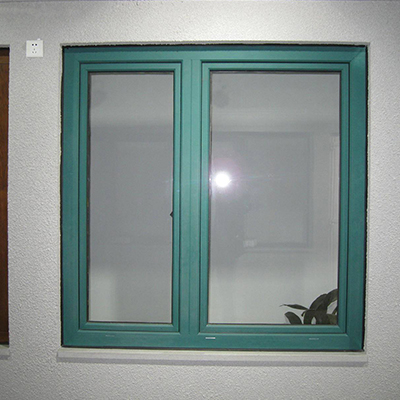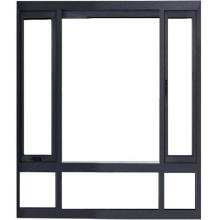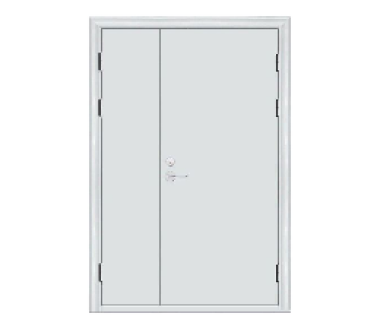In the field of building fire safety, fireproof doors and windows are the core barriers to curb the spread of fire and ensure the evacuation of personnel. With the increasing demand for lightweight, durability and aesthetic design in modern buildings, aluminum alloy fireproof doors and windows manufacturers have redefined the performance boundaries of fireproof products through material innovation, process upgrades and intelligent transformation, and have become an important part of the urban safety system.

Traditional aluminum alloys are limited in their application in the field of fire protection due to their low melting point and easy deformation. Modern manufacturers have given aluminum alloys the characteristics of “hardness and flexibility” through material modification and composite technology:
High-silicon aluminum alloy substrate: Research and develop special alloys with a silicon content of 12%-16%. The silicon element forms a dense oxide layer at high temperature, wrapping the base metal and delaying the softening process. Experiments show that the alloy can still maintain structural integrity for more than 40 minutes at a high temperature of 800°C, which is 4 times more fire-resistant than ordinary aluminum alloys.
Multi-cavity insulation structure: adopts “metal skeleton + inorganic fireproof core board” composite profile, the core board is made of expanded perlite or vermiculite board, which expands and foams when exposed to fire, fills the profile cavity, and blocks heat conduction. Through finite element analysis to optimize the profile section, the fire resistance limit of the window frame reaches 1.0 hour (Class B standard), and the weight is reduced by 30%.

Nano protective coating: ceramic-based nano coating is used to replace traditional spray paint. The coating thickness is only 30 microns but can withstand high temperatures of 1200℃, and has self-cleaning and corrosion resistance. According to the salt spray test, the coating life exceeds 15 years and is suitable for coastal and industrial pollution areas.
II. Process innovation: the integration of precision manufacturing and intelligent production
Aluminum alloy fireproof door and window manufacturers use digital equipment and flexible production lines to achieve efficient production from standardization to customization:
Precision molding of profiles: Use 10,000-ton extruders to produce special-shaped fireproof profiles, cooperate with laser cutting and five-axis machining centers to achieve one-time molding of complex window types, reduce welding points by 70%, and reduce the risk of embrittlement in the heat-affected zone. The wall thickness of the profile is controlled within ±0.03mm to ensure structural strength.
Fireproof glass composite technology: The “vacuum magnetron sputtering + nano-laminated” process is used to deposit antimony tin oxide (ATO) insulation film on the glass surface, and the thickness of the fireproof adhesive layer is accurately adjusted to 1.0mm. After testing, the glass still has a light transmittance of 75% in a 90-minute fire resistance test, and the impact resistance is improved by 50%.
Intelligent corner assembly and sealing system: A hydraulic corner assembly machine is used to achieve 45° seamless splicing, and the corner assembly strength reaches 6000N; graphene-based fireproof sealant is filled between the window frame and the glass, and the expansion rate in case of fire exceeds 600%. With the design of four sealing strips, the air tightness of the entire window reaches the highest level of the national standard (level 8), and the smoke penetration rate is less than 0.05%.

Excellent manufacturers not only provide products, but also build a closed-loop service system covering design, installation and operation and maintenance:
Fire protection compliance design: equipped with a team of registered fire protection engineers, customizing window size, opening method and distribution plan for customers according to the “Architectural Design Fire Protection Code”. For example, in a chemical park project, the effectiveness of fire partitions was improved by 35% by optimizing the layout of fireproof doors and windows.
Construction qualifications and standardized installation: the installation team is required to hold dual qualifications of “building metal doors and windows” and “fire protection facility construction”, and use BIM technology to rehearse the installation process to ensure that the verticality error of the window frame is ≤0.3mm/m, avoiding fire protection failure due to installation deviation.
Digital operation and maintenance platform: Develop a fireproof door and window status monitoring system, through embedded profile temperature sensors and displacement sensors, real-time feedback of window deformation, sealing strip aging degree and other data, early warning of potential risks, and reduce maintenance costs by 50%.
Aluminum alloy fireproof door and window manufacturers are reshaping the standards of building fire safety with materials as shields, processes as spears, and services as chains. From formula development in the laboratory to precision manufacturing in the workshop, from standardized installation on the construction site to intelligent operation and maintenance in the cloud, every link embodies the ultimate pursuit of safety. In the future, with the advancement of green buildings and smart cities, aluminum alloy fireproof door and window manufacturers will continue to explore lightweight, modular and digital technology paths to build a safer and more livable space environment for humans.